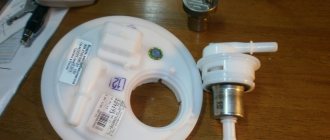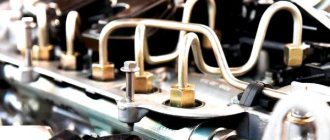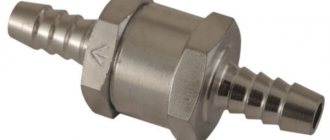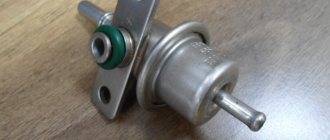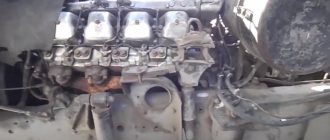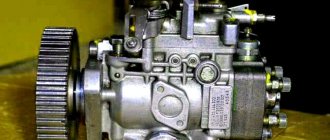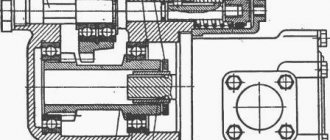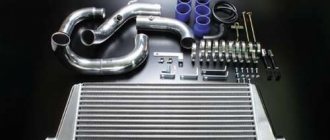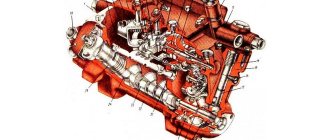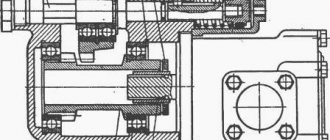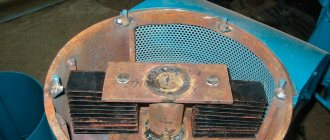Fuel system safety valve
It goes without saying that vehicle fuel systems are quite complex devices, which it is better not to approach without specific knowledge. On the other hand, knowledge of hardware and some experience is already considered as an opportunity to independently repair this or that defect. For example, if a fuel system check valve requires attention.
Check valve problems
For what reason does the fuel system valve fail? Let's figure it out together. Today there are three obvious reasons for refusal to work.
- Installation of low-quality Chinese goods that quickly fail. Basically, these are fakes for a certain brand.
- The second reason is the natural wear and tear of the product. In this case, either the spring or the membrane fails. Note that the valve itself rarely fails.
- Another problem for a non-removable mechanical structure is low-quality fuel.
Having decided on possible problems, let's move on to the signs indicating a problem.
Check valve functions
Fuel system check valve: 4 main malfunctions and ways to eliminate them
Fuel pumps of modern cars have high performance and, with proper care, provide a continuous supply of fuel, regardless of the load. It is impossible for the engine to operate at idle speed without a fuel system check valve.
The main purpose of this valve is to prevent the build-up of too high pressure in the fuel system, which could result in the fuel hoses breaking. In principle, the purpose of any valve is to allow the movement of different fluids in one main direction. Located in the fuel system, this valve prevents a number of problems that can arise in the system as a result of broken hoses.
What are the features of the diesel engine power system? You can learn about this from the detailed material of our author.
We also advise you to carefully study our expert’s article, which describes in detail how the fuel level sensor works.
If the driver stops the engine, while fuel flows into the tank along the working line, then the vacated space is quickly filled with air. In such situations, you will have to turn the engine with the starter for at least fifty seconds.
Engine power supply system ZMZ-40524
Fuel supply is carried out through distributed fuel injection into the intake pipe in the area where the intake valves are located using four electromagnetic injectors operating according to a signal from a microprocessor control unit. Control unit depending on
engine operating mode changes the duration of opening of the fuel injectors.
Maintaining constant fuel pressure in the line to ensure guaranteed fuel supply to the injectors in all engine operating modes is ensured by a fuel pressure regulator. The fuel pressure regulator maintains a pressure of 392-408 kPa (3.92-4.08 kgf/cm 2 ) in the vehicle’s fuel system. The fuel pressure regulator together with the fuel level sensor are part of the submersible electric fuel pump module located in the fuel tank.
The principle of operation of the main elements of the fuel unit
What is the valve in the oil filter for?
Video Replacing the cabin air filter on a VAZ 2114 VAZ 2115 VAZ 2113 Lada Samara 2
Fuel system VAZ 2114
Container for storing flammable materials
It is made of steel, consists of two firmly welded parts, the neck through which the fuel enters is connected to the tank with a rubber pipe and secured with clamps.
Gasoline pump
This tool with an electric mechanism is located in a tank with a fuel mixture level indicator. Its actions are coordinated by the engine control box, through a special pump relay, which supplies fuel through the line to the injectors. At idle or when the engine is completely turned off, the pressure is maintained due to the action of a one-way lock, which is located near the unit itself.
The VAZ 2114 power system has a fuel pressure regulator and injectors. The voltage is supplied to them from the battery through the main relay. Thus, the amount of driving fluid is indicated by the duration of the pulses, which are generated by the engine control unit and transmitted to the injectors.
Ramp
Located on the intake manifold, it includes a fuel control element and a pressure valve with a spring-loaded diaphragm. It, in turn, divides the regulator body into 2 parts: the fuel part regulates the pressure of the combustible mixture, the air part, due to the rarefaction of the air, raises the membrane and produces constant fuel pressure readings in the rail.
When the engine starts, the vacuum behind the damper decreases, the diaphragm closes the power system valve, so the pressure increases. When the vacuum is maximum, then the fuel pressure decreases. The regulator is not dismountable, so if it fails, it is replaced with another one.
Fuel mixture control sensor
The pump module has a float, which is located in the tank cavity. When the position of the float changes, the resistance of the unit changes proportionally. According to a certain signal, the fuel quantity indicator on the dashboard displays the presence of fuel in the system.
Why does the sensor often fail?
- fragility of the case;
- frequent temperature changes;
- condensation formation in the tank;
- when using a low-quality combustible mixture;
- oxidation of contacts when sealing is broken.
That is why it is so important to carry out preventive maintenance on time, clean the unit, change contacts in order to prevent its destruction. Changing a device is not that easy. Many markings are original and unique, which means that the services of professionals will be required, which are also not cheap
Many markings are original and unique, which means that the services of professionals will be required, which are also not cheap.
Hoses and pipelines
Such irreplaceable products guarantee uninterrupted circulation of flammable liquid from the container to the main line and nozzles, and if there is excess, they transfer the residual liquid back to the tank. The pipelines are located on the bottom of the vehicle, they need to be carefully checked, cleaned, inspected for integrity, various deformations identified and promptly eliminated in order to avoid fuel leakage, as well as poor transmission to the injectors.
Another function of the pipelines is the transfer of fuel vapor from the tank to the activated carbon section, where waste is collected when the engine is turned off. After it is started, the electromagnetic device is triggered and the vapors escape into the engine, where they are destroyed.
Highway
The design of the VAZ 2114 fuel system includes a main line that guarantees the supply of fuel to all injectors. Today, the fuel pressure regulator is placed in the tank and is not located on the line; there is also a service valve, which performs the function of eliminating air after a technical inspection of the vehicle.
The fuel injection system of the VAZ 2114 includes an uninterrupted mode for collecting fuel vapors, and the gravitational unit located in the device helps prevent fuel from leaking when the vehicle is in an emergency position.
When the engine's air consumption is high, the system is purged more intensively. The filter element is made of durable paper material, after which the air moves through the mass air flow sensor and moves into the intake hose, which leads to the throttle assembly.
Thus, the operation of the fuel fluid supply mode of an engine with a fuel injection system on a VAZ 2114 car occurs.
Where is the fuel check valve located?
What is a VAZ-2114 adsorber and what is it for?
Let's find out where the fuel system valve of various cars is located.
- In power plants with an injector, it can be installed in the gasoline pump housing.
- Mounted on the fuel frame or installed directly in the fuel line. This is the space between the gas tank and the fuel injectors.
On diesel power plants, the mechanical structure is hidden between the fuel injection pump and the low-pressure pump. This arrangement of the product allows you to create a stable pressure at the outlet of the high-pressure pump.
The system has proven itself well:
- on a domestic truck: KAMAZ 740;
- Czech clubfoot Tatra;
- on Mana;
- and Renault Magnum.
In diesel installations where a pre-start heating system is provided, the fuel check valve is located in front of the heating system. A typical example is the same KamAZ or Magirus trucks operating in the Far North.
On domestic passenger cars, such as the VAZ 2110 and 2114 with sixteen valves, the mechanical structure is located in the gasoline pump and on the fuel frame. This is analogous to installing a diesel engine.
Today, old carburetor cars with rear-wheel drive still run on our roads: eights and nines (VAZ 2108 and VAZ 2109). On them, the role of the return device is assigned directly to the gasoline pump.
It stands on the cylinder block and prevents the passage of fuel in the opposite direction: into the fuel tank.
The fuel supply system of automobile gasoline and diesel power units is a technically complex device that should not be approached without knowledge. And even more so, try to carry out technical treatment on your own.
The check valve plays an important role in the regular supply of fuel.
Let's focus our attention on its design and installation in the car. Let's look at the problems and characteristic signs of a malfunction
We will also decide on ways to check it.
Types of valves
Modern injection pumps use several valves. One of the main ones is injection. Let's consider its functions and tasks.
It is customary to distinguish discharge valves by type: cylindrical, combined, mushroom, etc.
| Mushroom discharge valve | |
| Most widespread | Diesel systems |
| Valve with suction belt | It is pressed against the socket by a spring and its lifting depends on the limiter |
| Operating principle | During the injection process, fuel presses from below on the valve mushroom, as a result of which it rises and opens access to the injector. When the supply stops, the spring lowers the valve down and then presses it tightly against the seat. When the suction belt enters the guide, the volume of the discharge line increases and the pressure in the system decreases. |
| Cylindrical valves | |
| Form | Cup |
| Weight | The mass of cylindrical valves is less than that of mushroom valves. They allow for a noticeable reduction in the volume of the fitting. |
| Plate valves | |
| Device | They are simple in design, have low mass, and therefore have low inertia. |
| Operating principle | As the pressure increases, both plates rise. When the lower plate rests against the protrusion of the nut, the upper one continues to move upward and allows fuel to access the fitting. |
| Combination valves | |
| Purpose | Combination valves are used to eliminate vibrations in the fuel injection line. |
| Operating principle | The valve consists of two plasti, one of which is loaded with a spring. During the pumping process, plate 1 moves upward and rests against the body with its protrusions. Fuel passes through the hole in the bottom plate, flows around the top plate and enters the fuel injection line. After the fuel pressure is cut off, the upper plate is pressed against the lower plate, decoupling the fuel line and the high-pressure pump. |
| Double valves | |
| Scope of application | Double valves are installed in critical heavy diesel engines. |
| Purpose | The presence of two sequentially located valves ensures greater reliability of the fuel system, as it creates greater tightness of the unit. In addition, if one of them fails due to jamming or solid contaminants getting under the cone, the other continues to independently perform the functions of isolating the pipeline and the pump. |
Check valve problems
For what reason does the fuel system valve fail? Let's figure it out together. Today there are three obvious reasons for refusal to work.
- Installation of low-quality Chinese goods that quickly fail. Basically, these are fakes for a certain brand.
- The second reason is the natural wear and tear of the product. In this case, either the spring or the membrane fails. Note that the valve itself rarely fails.
- Another problem for a non-removable mechanical structure is low-quality fuel.
Having decided on possible problems, let's move on to the signs indicating a problem.
Fuel pressure regulator (reducing valve) - design and functions
In automobile engines with an injection system, a fuel pressure regulator is used (also called a pressure reducing valve). In engines of this type, the amount of fuel injected is determined by the injection duration and the composition of the combustible mixture (its proportions).
In systems with fuel recirculation, the RTD installed on the fuel rail drains the excess fuel supplied to the injectors back into the tank. In systems without recirculation, the RTD is installed in the fuel pump housing or in the tank, and ensures stable fuel pressure in the system relative to atmospheric pressure. The engine power in such a system is regulated by the duration of fuel injection into the injectors.
Structurally, the RTD is a membrane that equalizes the fuel pressure, on the one hand, and the pressure of the pressure spring and the air entering the engine, on the other.
What is a check valve
The check valve in the fuel system should only allow fuel to flow in one direction. This is the main purpose of OKDT. When the fuel pump is not working, the device automatically closes the return fuel line to prevent unused fuel from flowing into the tank.
When the valves are working properly, the pressure in the main pipes does not drop for a long time after the engine stops. The small part is calibrated. The design consists of several elements:
- housing with outputs;
- ball-type valve with a seat made of soft metal;
- membrane;
- spring.
Comment!
Improving the starting characteristics of the internal combustion engine is the main function of the exhaust valve. A working part installed in a certain location in the fuel line maintains the optimal value of the residual pressure.
It is not difficult to understand how a valve installed on a ramp works:
- When the fuel injection pump is running, OKDT does not interfere with the movement of fuel in the forward direction.
- When the fuel pump turns off (when the engine stops), a reverse flow of working fluid occurs in the line.
- The reverse flow of fuel creates pressure, which closes the valve.
- The fuel remains in the line, creating residual pressure.
The operation of the entire fuel system of the vehicle depends on the small device. If there is no residual pressure in the line, it must be created every time the engine is started. The driver is forced to spend extra time cranking the starter.
How to find your device
There are models in which the valve is mounted in the fuel rail housing. A common installation location is the section of the fuel line located between the injectors and the tank.
There are vehicles in which the part is mounted directly into the fuel pump housing. In modern cars equipped with a fuel preheating system, the OKDT housing is located before the preheater. The installation location depends on the make of the machine:
| Brand, model) | Where is OKDT installed? |
| Renault Magnum | In between the fuel pumps |
| Tatra | |
| KAMAZ 740 | |
| Magnum trucks | Before the heating system |
| VAZ 2114 | Gasoline pump |
| VAZ 2110 (16-valve model) |
Reference!
In older cars, the fuel pump was installed on the cylinder block. It was equipped with a sealed exhaust valve to prevent unused fuel from flowing back into the tank.
Why is OKDT confused with RDT?
Many car enthusiasts consider the fuel pressure regulator (FPR) to be a check valve. In fact, these are parts of different design and purpose. RTD valves come in two types:
- modulated by atmospheric pressure;
- vacuum-modulated.
Reference!
The purpose of the RTD is to maintain a certain level of pressure in the pipes. It is installed in the fuel lines of two types of engines - diesel and injection. The pressure regulator valve always operates in parallel with the OKDT.
In vehicles with “return”, the mounting area of the pressure control valve is located on the fuel rail. It is located between the fuel rail and the return line. If the return line is not included in the circuit, the part is installed in the fuel tank housing. The performance of the injectors and the stable operation of the engine depend on the proper operation of the device.
Site about off-road vehicles, SUVs, off-road vehicles
The fuel supply system for the ZMZ-40524 engine on Gazelle and Sable cars consists of a fuel tank, fuel lines, an electric fuel pump module with a fuel level sensor, a fine fuel filter, an engine fuel rail, and electromagnetic injectors.
Fuel supply system for the ZMZ-40524 engine on Gazelle and Sobol cars, composition, device, principle of operation.
Fuel is supplied through distributed injection into the intake channels of the cylinder head in the area where the intake valves are located using electromagnetic injectors operating according to a signal from the microprocessor control unit. The control unit, depending on the engine operating mode, changes the duration of opening of the fuel injectors.
Schematic diagram of the fuel supply system for the ZMZ-40524 engine on Gazelle and Sobol cars.
Maintaining constant fuel pressure in the line to ensure guaranteed fuel supply to the injectors in all engine operating modes is ensured by a fuel pressure regulator. The fuel pressure regulator maintains a pressure of 392-408 kPa (3.92-4.08 kgf/cm2) in the vehicle’s fuel system. The fuel pressure regulator together with the fuel level sensor are part of the submersible electric fuel pump module located in the fuel tank.
Work order
- First, disconnect the negative terminal from the battery (key to “10”).
- Disconnect the regulator vacuum hose from the intake manifold fitting.
- Using a “17” wrench, unscrew the nut securing the drain hose. Disconnect the hose.
- Using a Phillips screwdriver, unscrew the bolt of the return pipeline clamping plate.
- Using a hex wrench set to “5”, unscrew the screws securing the RTD to the fuel rail.
- Using a “24” wrench, unscrew the nut connecting the drain hose fitting and the RTD.
- Remove the fuel pressure regulator.
That's basically the whole process. Installation of the RTD is carried out in the reverse order
Important: do not lose the rubber seal that comes with the regulator. Without it, the connection between the RTD and the fuel rail will be leaky, which will lead to a change in the operating pressure in the system
Review of faults and methods for repairing them
By analogy with the previous version 406, the ZMZ 405 motor ensures the safety of the valves in the event of a sudden break in the timing chains. However, the valves bend against each other if the chain jumps over several links - at the moment of simultaneous lifting of the intake and exhaust valves inside one cylinder.
Power and control circuit
A positive feature of the motor is the ability to operate two types of timing chains. It is possible to replace toothed chains with bushing ones, but only in combination with rollers, sprockets, tensioners, and dampers. The main failure is a characteristic knocking sound, which can occur for several reasons:
| Wear of the attachment drive belt guide roller bearing | bearing replacement |
| Loose damper pulley | bolt pulling |
| Pump bearing production | replacement of consumables |
| Broken tensioner spring | using a new spring |
| Generator bearing failure | replacement of consumables |
| Valve spring settlement | installing a new spring |
| Valve stem scuffing | cylinder head repair |
| Extended chain | stretching or replacement |
| Hydraulic tensioner failure | unit repair |
| Production of hydraulic pushers | replacement of consumables |
| Wear of the cylinder, shpg or crankshaft liners | repair of block, cylinder head, piston group |
Unlike the 406 version, the atmospheric modifications of the 405 series are not prone to overheating.
Device and principle of operation
The check valve device is simple. The entire mechanism consists of a spring, a membrane and the valve itself. The ball-type valve is equipped with a special seat, which is made of soft metal and is calibrated as accurately as possible.
The valve body is equipped with three outlets: the first is for the intake manifold, and the others are for fuel removal. Fuel moves freely through the valve in only one direction.
It is not able to flow back into the valve due to the pressure created on it, which is why it closes. The valve opens due to the movement of the spring resulting from the vacuum as the engine speed increases. Excess fuel is returned back to the fuel tank.
The fuel system valve is often confused with the pressure reducing valve. To avoid this, read the vehicle's operating instructions in detail. The pressure reducing valve is used in injection and diesel engines and operates in parallel with the check valve of the fuel system.
The check valve for diesel fuel is no different in operating principle from its “brother” used in gasoline engines; differences can only arise in the location of this unit.
Reference
Many people know that the fuel system valve aggregates:
There is nothing complicated about the mechanical design. This is a ball-type device with a seat, which is made of soft metal, with the most accurate balancing. Fuel flows freely through the fuel valve in one direction. The pressure that is created prevents gasoline or diesel fuel from flowing back into the fuel tank, since the non-demountable structure is locked.
Despite its simplicity, the device can cause a lot of trouble for a novice and an experienced driver. Therefore, it is necessary to know its possible vagaries and ways to eliminate breakdowns. But first of all, understand where the mechanical structure is installed.
“The concept of a fuel system check valve should not be confused with a pressure reducing device.”
Possible malfunctions of the RTD
Considering that the design of the pressure regulator is mechanical, malfunctions in its operation can occur quite often. The most common device malfunctions include:
- weakening of the membrane spring;
- valve jamming;
- regulator clogging;
- violation of the tightness of the junction of the regulator and the ramp body.
When the diaphragm spring weakens, the valve cannot cope with the air pressure coming from the intake manifold. As a result, the pressure and amount of incoming fuel are reduced.
Valve jamming leads to an uncontrolled supply of fuel to the manifold and its “waste” into the fuel line. In this case, gasoline consumption increases, and the engine stops starting normally due to interruptions in the fuel supply.
Similar signs of malfunction can be observed when the regulator is clogged. Dirt and deposits reduce the throughput of the system, as a result of which the fuel pressure decreases significantly, the engine “chokes”, and normal idle speed disappears.
If the seal between the regulator and the ramp is broken, the air pressure may drop, which again will lead to a decrease in fuel pressure.
Engine timing chain marks 405
When installing marks on the engine of a Gazelle car, experienced mechanics do not recommend turning the crankshaft counterclockwise. Timing timing marks are set according to the engine operating manual.
For example, the marks on the camshaft sprockets should be horizontal. They go in opposite directions from each other. The alignment of the timing marks along the upper plane of the cylinder head is maintained.
The marks are set so that the valves in the engine open and close in accordance with the phases that engineers have laid down in the ZMZ 405 motor. If there is a slight inaccuracy in setting the marks, this will lead to the fact that the valves may not open or close in time. Such behavior is fraught with destruction of the cylinder head and major overhaul of the entire engine.
How can you check a check valve?
You can find out what condition the fuel valve is in as follows.
Using a pressure gauge, check the pressure. It should be within 3 kg per cm 2. These are figures for passenger cars.
You can find out how the device works by pinching the “return” fuel hoses. If the permanent mechanical structure is in order, the pressure should increase.
This method is only for cars that have rubber hoses installed.
Self-diagnosis can be carried out without using a pressure gauge. This concerns the problem of unstable operation of the internal combustion engine (ICE) and poor acceleration
Having pinched the rubber hose that moves the fuel in the opposite direction, you need to pay attention to the operation of the engine. If the speed increases and the engine cylinders operate as planned, then the check valve is faulty
Troubleshooting methods
To replace a faulty part, select a spare part with a cross-section of the same size as the old device. If there is a discrepancy, the valve will start to skip. The installation location is chosen in the area between the filter and the fuel pump.
Comment! It’s easy to check the operation of a new part. They drive up a hill, if the power does not drop sharply, then the product fits perfectly.
In some car models, it is easier to change the fuel pump than to remove a faulty check valve. Usually such a solution is offered at service stations. Car enthusiasts who repair their cars themselves choose other options:
- wash the part from clogging with a powerful stream of water, use a car wash for this;
- remove dirt particles by lightly tapping the body;
- install another check valve on the fuel line.
If a “symptom” of a check valve malfunction appears, experts recommend diagnostics. It doesn’t matter where to do it - at a service station or on your own, the main thing is to find the cause of unstable engine operation and eliminate it in time.
Examination
If you find characteristic symptoms, first we recommend that you make sure that the problem with the car is related specifically to this sensor.
The inspection is carried out as follows:
- At the end of the ramp block there is a fitting designed to check the pressure indicator;
- It is covered with a plug that you need to unscrew;
- At the bottom of this plug there is a ring that compensates for the distance;
- If there are signs of damage or defects on the ring, be sure to replace it with a new one;
- Now take the cap from the tire and unscrew the spool with its back. It is located in the middle of the fitting;
- Now a flexible hose from the measuring device is connected to the fitting. You can use a regular pressure gauge that you use when inflating tires;
- Clamp the hose with a clamp and start checking;
- Turn on idle, since this is where the vacuum is the lowest and the fuel pressure is the highest;
- Start the engine. The device should show 2.9-3.3 units;
- Now check the readings, only without the vacuum hose;
- Having removed it, the pressure gauge should give about 0.2-0.8 units. If no changes occur, then the regulator is definitely out of order and needs to be replaced.
Article on the topic: We remove, check (3 methods) and replace the diode bridge on a VAZ 2114
Fuel pressure check valve (OKDT) - design and functions
The purpose of a check valve in any hydraulic system is to allow fluid to pass through itself in only one direction. In the fuel system of a car, such a valve is necessary to ensure that the fuel entering the fuel system does not flow back into the tank after the fuel pump is turned off.
Typically, the design of a check valve is extremely simple - the shut-off and control element in it is a ball or cone, which does not prevent the flow of fuel under pressure into the fuel system, but when the pressure stops, it prevents the fuel from flowing back, locking the valve seat with its own weight or under the action of a pressure spring.
The fuel check valve can be installed anywhere in the fuel system - from the gas tank to the fuel rail (the part of the fuel system responsible for distributing fuel to the injectors). In diesel engines with preheating, OKDT is placed in front of the heating system.
Main features of check valves
A device such as a check valve is small in size, but is quite powerful and ensures a constant direction of water flow in the pipes. Similar valves are installed in both main and in-house water supply systems. Without a check valve at the end of the suction pipe, water will simply flow back if the centrifugal pump stops. As a result, air pockets will form in the pipeline, which will cause electrical equipment to burn out.
Depending on the installation location, there are bottom and pipeline valves. The former serve to maintain the force and direction of flow in the event of pumping equipment failure. Pipeline models, including axial and flap models, are necessary to prevent pressure drop in the system. Thus, check valves ensure efficient and reliable operation of the pumping station and protect the water supply system, pump and plumbing from water hammer.
Where is the fuel check valve located?
Let's find out where the fuel system valve of various cars is located.
- In power plants with an injector, it can be installed in the gasoline pump housing.
- Mounted on the fuel frame or installed directly in the fuel line. This is the space between the gas tank and the fuel injectors.
On diesel power plants, the mechanical structure is hidden between the fuel injection pump and the low-pressure pump. This arrangement of the product allows you to create a stable pressure at the outlet of the high-pressure pump.
The system has proven itself well:
- on a domestic truck: KAMAZ 740;
- Czech clubfoot Tatra;
- on Mana;
- and Renault Magnum.
In diesel installations where a pre-start heating system is provided, the fuel check valve is located in front of the heating system. A typical example is the same KamAZ or Magirus trucks operating in the Far North.
On domestic passenger cars, such as the VAZ 2110 and 2114 with sixteen valves, the mechanical structure is located in the gasoline pump and on the fuel frame. This is analogous to installing a diesel engine.
Today, old carburetor cars with rear-wheel drive still run on our roads: eights and nines (VAZ 2108 and VAZ 2109). On them, the role of the return device is assigned directly to the gasoline pump.
It stands on the cylinder block and prevents the passage of fuel in the opposite direction: into the fuel tank.
The fuel supply system of automobile gasoline and diesel power units is a technically complex device that should not be approached without knowledge. And even more so, try to carry out technical treatment on your own.
Analogs
There are analogues on sale from various manufacturers - domestic and Chinese. It is possible to purchase a replacement chain separately or as a complete set. The price depends on the origin of the parts and the place of purchase. It is advisable to give preference to well-established auto shops.
| Name | vendor code | Price |
| Olmi | 406.1006040-20 | From 1,300 rubles |
| Miles | 040900100011801 | From 1,150 rubles |
| Ditton | 509105011801 | From 1 117 |
Where is the fuel system check valve located?
The location of the regulator directly depends on the design of the system. It can be located between the fuel injectors and the tank, on the ramp, or mounted in the fuel pump structure. The type of fuel also affects where the fuel system check valve will be located. The diesel engine has a distinctive design and places the regulator close to the injection pump and low pressure pump to ensure stable pressure at the pump inlet. In addition, it can be installed in front of the heating system; this option is common in vehicles that have pre-heating of the fuel.
Location
Where is the fuel system check valve located? You can find this parameter in the instructions, but most often this valve is attached to the fuel rail in the housing. The fuel rail is a metal structure onto which, in addition to our valve, the injectors responsible for injecting fuel into the engine are also attached.
In some ramps, the check valve is screwed into the end with a thread. On some vehicles it may also be located between the fuel tank and the injectors in the fuel line.
In diesel vehicles, due to the fact that the pressure at the inlet of the injection pump (high pressure fuel pump) must remain stable, a check valve is attached between the low pressure hand pump and the injection pump. If the car has a special fuel preheating system, then a check valve is installed in front of this system.
Lada Priora Hatchback ✤ℨℰȴеℋÅЯ МОШℵИЯ!!! › Logbook › The main thing about the pressure in the fuel system.
Fuel pressure in the car system is one of the important parameters that is used in engine diagnostics. The behavior of the car in various operating modes depends on the pressure. How to measure the pressure in the fuel system with your own hands
For example, buy a device to check fuel pressure. A kit with a fuel pressure gauge, adapter and drain will cost you 1400-1500 rubles. Pay 300-400 rubles to the service station and take measurements there. You can also measure the pressure in the fuel system with an air pressure gauge, which is used to measure tire pressure. Here at this point in more detail. Let's take the example of the tenth VAZ 2110 family. Otherwise, the procedure is similar to any other car. The peculiarity of pressure gauges is that their initial scale values have relative inaccuracy. What does it mean. If the air pressure gauge has a scale of up to 16-20 atm (when the measurement limit for fuel is 5-7 atm), then pressure measurements will not be accurate due to this error, which will fall within the initial values of the instrument scale. Therefore, it is correct to check the fuel pressure with a fuel pressure gauge with a limit of 6-7 atm.
We take a pressure gauge and wrap a piece of foam (plumbing flax) under the pipe and put on an oxygen hose with an internal diameter of 9 mm. Secure with clamps. Place a rag on the generator (so as not to start a fire under the hood). Unscrew the plastic cap on the fuel rail.
put the hose on the pressure gauge
Under the cap there is a hole with a nipple. Unscrew it from the wheel cap. Due to the residual pressure in the rail after removing the nipple, gasoline will splash out.
If desired, you can relieve the pressure in the vehicle's fuel system. To do this, you need to remove the fuel pump fuse and wait until the running car stalls.
We put the second end of the hose on the ramp hole and secure it with a clamp. We remove the rag from the generator and start the engine. Don’t forget to cover the generator with a rag again before removing the hose from the ramp. That's it, now you know how to check the pressure in the fuel system in the field.
attach the hose with pressure gauge to the fitting
check the fuel pressure in the system
By the way, instead of clamps, you can use the classic adjusting bolt bushing. It screws perfectly onto the ramp fitting. To seal, we put a suitable rubber ring on the fitting. On the other side of the bushing we solder a fitting onto which we put a hose with a pressure gauge.
What pressure should be in the VAZ 2110 fuel system? 2.8–3.2 bar (2.8–3.2 atm)
How to measure fuel pressure in a system where there is no return? On VAZ 2110 with 1.6 liter engines, the pressure in the ramp is constant and amounts to 3.6-4.0 atm. Otherwise, the measurement technique is similar. Alternative ways:
It is measured at the outlet fitting of the fuel pump module - this is the one with one tube. You will need a flexible gas-resistant hose with an internal diameter of about 8 mm and a pressure gauge (you need to remove the tube and put on a hose with a pressure gauge instead). The pressure should be 5-7 atm. Close the return line, as is done on an internal combustion engine with a drain ramp, but you must turn it off again at the fuel pump itself. We pull off the second hose (double) and insert a plug into the removed hose, made, for example, from an old fuel filter (saw off the nipple from it and plug it). A single hose must be put on the pump fitting, and now the measurement must be made at the fuel rail. According to the power system diagram, everything will be clear.
What to pay attention to
There are characteristic signs indicating a malfunction of the check valve:
- unstable operation of the engine at minimum speed;
- the engine starts only after a long rotation of the starter and simultaneous pressing of the gas pedal;
- gasoline leakage from fuel hoses, which does not go away after replacing them and tightening the clamps;
- sudden change in idle speed.
Due to the mechanical design of the fuel system check valve, its functionality cannot be checked using special instruments used for electronic sensors. However, it cannot be disassembled and cannot be repaired due to the unavailability of individual parts for sale and the low cost of the structure itself.
The pressure level in the fuel system allows you to determine the serviceability of the valve. You can measure it with a pressure gauge by connecting it to the section that supplies power to the motor. Afterwards, all that remains is to record the device’s readings. For passenger cars, the normal pressure level should be approximately 3 kg/cm2. In this case, there should not be a sharp decrease in the level when the engine stops. A rapid decrease in pressure indicates that there is a malfunction in the fuel system check valve.
Diagnostics and troubleshooting of check valve operation
So, you suspect that the vehicle's performance has decreased due to a malfunction of the fuel system check valve, and there are some signs of its malfunction. In order to find out whether this is so, several methods are used.
Most often, the pressure level is checked. An adequate pressure level should be about 3 kg/cm2 (for passenger cars). At the same time, the pressure level should not drop sharply when the engine is stopped. Otherwise, this will also be a sign of a faulty check valve.
As mentioned above, hose compression is sometimes used. But this method is not always suitable, since only a rubber elastic hose can be compressed.
Be sure to determine the reason why the fuel system is filling with air. If it is functioning correctly, a small amount of liquid should remain in the chamber awaiting the next engine start. If the valve is missing or worn out, air appears instead of this fluid. Starting the engine in such conditions will be disproportionately difficult.
So, as a result of measuring the pressure with a pressure gauge inserted into the rail, you concluded that after stopping the engine it began to drop significantly. In this case, either there is a defect in the fuel line, or the valve itself is faulty. If the result at the outlet of the fuel pump is different, then the valve is faulty.
To fix the problem, select a high-quality check valve from a spare parts store that fits the cross-sectional dimensions. If you select a valve with the wrong cross-sectional dimensions, it may begin to “slip.” Before purchasing, check the operation of the valve on site, if possible. The check valve must be cut into the line at any suitable location.
For example, this can be done between the fuel pump and the filter. After this, test the functionality of your car by driving it up a hill at an angle. If the car shows no signs of loss of power, then the valve has failed.
Sometimes there is no need to replace the valve, but the fuel pump itself needs to be replaced. However, this procedure is much more expensive. An alternative option is to install an additional valve. When choosing a valve, keep in mind that models for Russian cars often differ in cross-section from foreign cars.
There is also a folk method for troubleshooting, but it is only suitable if the valve is clogged. You need to hit the valve a couple of times with a hammer. The impact force must be calculated to avoid mechanical damage. With this effect, foreign bodies trapped in the valve can be crushed or even fly out of the valve. But most often it is much easier to replace the valve with a new one.
Characteristic symptoms of a check valve malfunction
It could be:
- unexpected change in speed of the power unit at startup or while driving;
- The engine can be started by pressing the accelerator pedal. Although before this the power unit was driven by a starter;
- Unstable engine operation at low or idle speeds;
- loss of fuel that escapes through the supply or return pipes. In this case, the sealing of the fuel hoses is not broken.
In our case, the non-removable mechanical structure can be easily repaired. This is on the one hand. On the other hand, the problem cannot be determined by scanning. Next, let's look at options for checking the device.
Possible controller malfunctions
The following errors may indicate device malfunctions:
- P0131, P0132. These errors indicate that the signal level from the oxygen sensor is too low or too high.
- P0134. The control unit did not detect the activity of the lambda probe.
- P0135. This error may indicate an open circuit connecting the sensor, as well as a possible short to power or ground.
- P0133. Controller response is too slow.
- P0137, P0138. Very low or high signal from the second lambda probe.
- P0141. The malfunction also concerns the second oxygen sensor, in this case we are talking about an open circuit or short circuit (the author of the video is the Lty D channel).
conclusions
The fuel system check valve is an important component of this system, the failure of which can cause a lot of problems for the driver. This will be especially painful during movement. Therefore, it is worth using only high-quality fuel, and at the slightest sign of a malfunction, which were listed above, diagnosing the fuel system.
After all, the problem may lie not only in the valve, but also in other small parts. Diagnostics at a service station almost always reveals such faults, so do not forget about timely maintenance of the car, even if everything seems to be in good order.
Which way to go
There are two options for eliminating the problem. Take the car to a service station and wait for the repairs to be completed. In this case, you need to shell out a certain amount of money, it’s a pity.
Having knowledge and understanding of the car’s structure, you can carry out repairs yourself. Saving money in person. However, there is a possibility of stepping on a pitfall. Can't deal with the problem.
Then you will have to shell out additional money for repairs in a specialized center, how do you like this prospect? In any case, the decision is yours to make.
Experts recommend not to reinvent the wheel, but to give the car to professionals who will replace it quickly, with a guarantee of quality.
Decide what is more important to you: savings or stable operation of the power unit, good luck to everyone!
